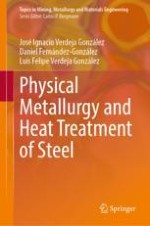This book covers the physical metallurgy of steels as well as the heat treatments used to improve the their properties. A full chapter is dedicated to the atmospheres in the steelmaking, including the implications of the own gases generated in the iron and steelmaking factories and how they could be applied in these treatments. This book is specially conceived for graduate and undergraduate courses, being the result of more than 30 years of teaching experience in courses for undergraduate, graduate (master and Ph. D.), and companies (technicians). The trends in the re-utilization of industrial gases in the iron and steelmaking process are discussed by the authors. Additionally, the book comprises 41 solved exercises, problems and case-studies, as a complement of the theoretical sections of the text. These exercises, problems, and case-studies are based on problems observed in the industrial practice.
